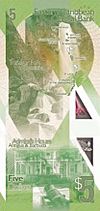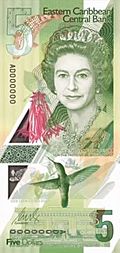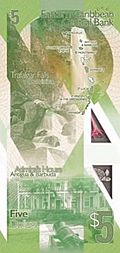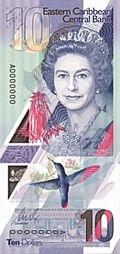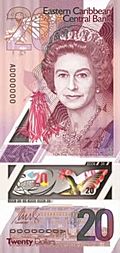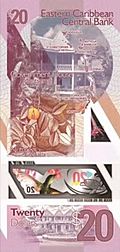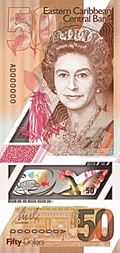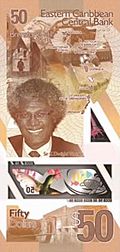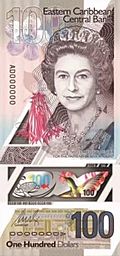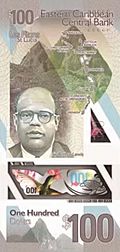Eastern Caribbean dollar facts for kids
Quick facts for kids Eastern Caribbean dollar |
|||||
|---|---|---|---|---|---|
|
|||||
| ISO 4217 Code | XCD | ||||
| User(s) | |||||
| Pegged with | U.S. dollar = XCD 2.70 | ||||
| Subunit | |||||
| 1⁄100 | cent | ||||
| Symbol | EC$ | ||||
| Coins | 5, 10, 25 cents, EC$1 | ||||
| Banknotes | EC$2, EC$5, EC$10, EC$20, EC$50, EC$100 | ||||
The Eastern Caribbean dollar (symbol: EC$; code: XCD) is the money used in eight different places in the Caribbean. These places are all part of the Organisation of Eastern Caribbean States (OECS).
This currency has been around since 1965. It took over from an older currency called the British West Indies dollar. You can write it as $ or EC$ to show it's different from other types of dollars. One EC dollar is made up of 100 cents. Since 1976, the EC dollar has been linked to the United States dollar. This means that 1 U.S. dollar is always worth 2.70 EC dollars.
Contents
Who Uses the Eastern Caribbean Dollar?
Six of the places that use the EC dollar are independent countries. These are Antigua and Barbuda, Dominica, Grenada, Saint Kitts and Nevis, Saint Lucia, and Saint Vincent and the Grenadines.
The other two places are Anguilla and Montserrat. They are British Overseas Territories, which means they are part of the United Kingdom. All these countries and territories are members of the Eastern Caribbean Currency Union. This union helps them all use the same money.
Some other members of the OECS do not use the EC dollar. For example, the British Virgin Islands use the United States dollar. Martinique, which is part of France, uses the euro.
In the past, British Guiana and Barbados also used the EC dollar. But they later decided to use their own currencies.
About 613,000 people live in the areas that use the EC dollar. This is similar to the population of a country like Montenegro. The total value of goods and services produced in these areas is about 5.46 billion U.S. dollars.
You will see Queen Elizabeth II on the banknotes and coins. She was the head of state for most of these places.
A Brief History of the Money
For a long time, people in the British West Indies used Spanish dollars. The British government tried to introduce their own money, the pound sterling, but it was hard to make people switch.
In 1949, the British government officially created the British West Indies dollar (BWI$). This currency was linked to the British pound. A group called the British Caribbean Currency Board (BCCB) was set up to print the money.
The BWI$ was used in many islands. But some places, like the British Virgin Islands, found it easier to use the U.S. dollar. They later switched to the U.S. dollar.
In 1955, new decimal coins were introduced for the BWI$. These coins were in cents.
The West Indies Federation was formed in 1958, and the BWI$ became its currency. However, some parts of the Federation, like Jamaica, kept their own money.
In 1965, the BWI$ was replaced by the Eastern Caribbean dollar. A new group, the Eastern Caribbean Currency Authority (ECCA), took over from the BCCB. Later, in 1983, the Eastern Caribbean Central Bank (ECCB) was created. This bank is now in charge of issuing the EC dollar.
The exchange rate of 4.80 EC dollars to 1 British pound continued until 1976. After that, the EC dollar was linked to the U.S. dollar.
Coins of the EC Dollar
Before 1981, the coins of the old BWI$ were still used. In 1982, new EC dollar coins were made. These came in values of 1, 2, 5, 10, and 25 cents, and 1 dollar.
The 1 and 5 cent coins had a wavy edge, and the 2 cent coin was square. These were made of aluminum. The 10 and 25 cent coins were round and made of a mix of copper and nickel. The 1 dollar coin was round and made of aluminum bronze.
In 1989, the 1 dollar coin changed. It became a 10-sided coin made of copper and nickel.
In 2002, new, larger 1, 2, and 5 cent coins were made. The 1 dollar coin also became round again. The picture of Queen Elizabeth II on all coins was updated to a newer design.
The 1 and 2 cent coins were removed from circulation in 2015. They were no longer valid to use after June 2020.
| Value | Technical parameters | Description | Date of first minting | ||||
|---|---|---|---|---|---|---|---|
| Diameter | Mass | Composition | Edge | Obverse | Reverse | ||
| 1 cent | 18.42 mm | 1.03 g | Aluminium | Plain | Elizabeth II | Value, year of minting, "East Caribbean States", 2-branch wreath | 2002 |
| 2 cents | 21.46 mm | 1.42 g | |||||
| 5 cents | 23.11 mm | 1.74 g | |||||
| 10 cents | 18.06 mm | 2.59 g | Cupronickel | Ribbed | Value, year of minting, "East Caribbean States", sailing ship | ||
| 25 cents | 23.98 mm | 6.48 g | |||||
| 1 dollar | 26.5 mm | 7.98 g | Alternate smooth and ribbed | ||||
| For table standards, see the coin specification table. | |||||||
Banknotes of the EC Dollar
In 1965, the Eastern Caribbean Currency Authority started printing banknotes. These were in values of 1, 5, 20, and 100 dollars. All of them showed a picture of Queen Elizabeth II.
When the Eastern Caribbean Central Bank took over in 1985, they added 10 dollar notes. The 1 dollar notes stopped being printed in 1989. In 1993, 50 dollar notes were introduced.
In 2008, a new series of banknotes was released. In 2012, the bank added special features for people who are blind or have low vision. These notes have raised dots that feel like cricket balls and stumps. This helps people tell the different notes apart. These features are on the 10, 20, 50, and 100 dollar notes.
In 2019, the Eastern Caribbean Central Bank started making new notes from a special plastic material called polymer. These new notes are also printed vertically, which is a unique design.
| Obverse | Reverse | Denomination | Obverse | Reverse |
|---|---|---|---|---|
| EC$5 | Queen Elizabeth II, turtle, Green-throated carib | Trafalgar Falls, Dominica; Admiral's House, Antigua | ||
| EC$10 | Admiralty Bay, Bequia, Saint Vincent and the Grenadines; Map of the Organisation of Eastern Caribbean States; brown pelican; tropical fish | |||
| EC$20 | Government House, Montserrat, Nutmeg | |||
| EC$50 | Sir K. Dwight Venner; Brimstone Hill Fortress National Park, St. Kitts; Map of the Organisation of Eastern Caribbean States, Tropical Fish | |||
| EC$100 | Sir William Arthur Lewis, Map of the Organisation of Eastern Caribbean States, View of the twin peaks of Les Pitons Volcano – Petit Piton and Gros Piton near Soufrière in Saint Lucia, Tropical Fish |
Older Banknote Designs
| Obverse | Reverse | Denomination | Obverse | Reverse |
|---|---|---|---|---|
| EC$5 | Queen Elizabeth II, turtle, Green-throated carib | Admiral's House in Antigua and Barbuda, Map of the Organisation of Eastern Caribbean States, silver compass rose, Trafalgar Falls in Dominica, tropical fish | ||
| EC$10 | Admiralty Bay in St. Vincent & The Grenadines, Map of the Organisation of Eastern Caribbean States, silver compass rose, The Warspite schooner in Anguilla, brown pelican, tropical fish | |||
| EC$20 | Government House Montserrat, Map of the Organisation of Eastern Caribbean States, silver compass rose, hands harvesting nutmeg in Grenada, tropical fish | |||
| EC$50 | Brimstone Hill fortress in St. Kitts, Map of the Organisation of Eastern Caribbean States, silver compass rose, Les Pitons (volcanoes) in St. Lucia, sooty tern, tropical fish | |||
| EC$100 | St. Lucian economist Sir William Arthur Lewis, map of the Organisation of Eastern Caribbean States, silver compass rose, Eastern Caribbean Central Bank building, Lesser Antillean swifts, tropical fish |
The 2012 issue included raised braille elements for the visually-impaired in the form of a cricket ball and stumps. These were added to the EC$10, $20, $50, and $100 banknotes.
| Obverse | Reverse | Denomination | Obverse | Reverse |
|---|---|---|---|---|
| EC$10 | Queen Elizabeth II, turtle, Green-throated carib | Admiralty Bay in St. Vincent & The Grenadines, Map of the Organisation of Eastern Caribbean States, silver compass rose, The Warspite schooner in Anguilla, brown pelican, tropical fish | ||
| EC$20 | Government House Montserrat, Map of the Organisation of Eastern Caribbean States, silver compass rose, hands harvesting nutmeg in Grenada, tropical fish | |||
| EC$50 | Brimstone Hill fortress in St. Kitts, Map of the Organisation of Eastern Caribbean States, silver compass rose, Les Pitons (volcanoes) in St. Lucia, sooty tern, tropical fish | |||
| EC$100 | St. Lucian economist Sir William Arthur Lewis, map of the Organisation of Eastern Caribbean States, silver compass rose, Eastern Caribbean Central Bank building, Lesser Antillean swifts, tropical fish |
| Obverse | Reverse | Denomination | Obverse | Reverse |
|---|---|---|---|---|
| EC$10 | Queen Elizabeth II, turtle, Green-throated carib | Admiralty Bay in St. Vincent & The Grenadines, Map of the Organisation of Eastern Caribbean States, silver compass rose, The Warspite schooner in Anguilla, brown pelican, tropical fish | ||
| EC$20 | Government House Montserrat, Map of the Organisation of Eastern Caribbean States, silver compass rose, hands harvesting nutmeg in Grenada, tropical fish | |||
| EC$50 | Brimstone Hill fortress in St. Kitts, Map of the Organisation of Eastern Caribbean States, silver compass rose, Les Pitons (volcanoes) in St. Lucia, sooty tern, tropical fish | |||
| EC$100 | St. Lucian economist Sir William Arthur Lewis, map of the Organisation of Eastern Caribbean States, silver compass rose, Eastern Caribbean Central Bank building, Lesser Antillean swifts, tropical fish |
| Current XCD exchange rates | |
|---|---|
| From Google Finance: | AUD CAD CHF EUR GBP HKD JPY USD EUR JPY |
| From Yahoo! Finance: | AUD CAD CHF EUR GBP HKD JPY USD EUR JPY |
| From XE.com: | AUD CAD CHF EUR GBP HKD JPY USD EUR JPY |
| From OANDA: | AUD CAD CHF EUR GBP HKD JPY USD EUR JPY |
| From fxtop.com: | AUD CAD CHF EUR GBP HKD JPY USD EUR JPY |
See also
 In Spanish: Dólar del Caribe Oriental para niños
In Spanish: Dólar del Caribe Oriental para niños
- CARICOM
- Central banks and currencies of the Caribbean
- Currencies of the British West Indies
- Currency union
- Eastern Caribbean Securities Exchange
- Economy of the Caribbean



